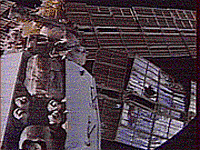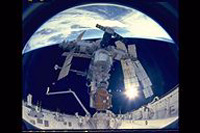Click on image for full size
NASA
Related links:
Mir Space Station Crippled By Collision!
News story originally written on June 27, 1997
The release of the movie Apollo 13 awakened many people to the struggle for survival that these astronauts endured during their lunar mission. The three men currently aboard the Mir space station are similarly fighting for survival because of a recent accident.
On Wednesday, June 25, at 5:18 a.m., the space station Mir collided with a cargo ship causing an air leak aboard the station and a crippling power outage. The men, U.S. astronaut Michael Foale, Mir commander Vasily Tsibiev, and flight engineer Alexander Lazutkin, were unharmed in the accident. But one of Mir's six labs was severely damaged and station power was decreased by 50%, so all but essential life-support systems have been turned off. The men do have enough food and water.
The space station Mir, like all spacecraft, is pressurized and maintains proper oxygen levels for life to exist. The hole that resulted because of the accident ruined this pressurized environment, and could have been fatal. Fortunately, the crew was able to close a hatch leading to the module that contained the leak. A space walk outside of Mir to repair the coin-sized hole is being discussed.
"It's a very serious situation," stated U.S. astronaut Jerry Linenger, who was aboard the Mir space station when a fire broke out last February. He continued, "Fire aboard a spacecraft and decompression are the two most dangerous things that can happen on an orbiting vehicle. It's about as critical as it can get."
The Russian news agency Novosti reports that the crew is safe and in no danger.Though the Soyuz escape craft is available, there are no plans for the crew to leave Mir at this time. In fact, help is on the way. The ITAR-Tass news agency reports that a supply ship will be launched July 4 or 5 to bring repair equipment to the space station.














